#Faq
Text
584 notes
·
View notes
Note
If someone wanted to make a remake of wizard of oz or willy wonka or snow white and the seven dwarves, what would you say would be the best way to fix the stereotypical depictions of magical or inhuman little people?
Would it be to just make them Not little people anymore, make them another creature, or to make them like, people with dwarfism?
I've heard some ppl bring up the idea of having dwarves in snow white be actual in-world little people as opposed to a mythical race of 'dwarves', but it seems that would carry its own problematic connotations to extend that to what is clearly a race (munchkins) or a pseudo enslaved/servant populace (oompa loompas)
would it be better to just remove these characters entirely or have their roles reprised by non-little people? On the one hand, it seems that many of them do not need to be little people, but on the other hand it seems a shame to remove roles for little people.
(i kind of feel oompa loompas are a bit hard to make work at all given they are explicitely black slaves in the original and clearly carry a sort of enslaved populace connotation in most adaptations, but I'm legitimately curious about munchkins, whose size doesn't seem to matter very much in most stories.)
Hello! My answer is to simply stop retelling these stories. The very fact that we hold onto them so dearly when they're as harmful as they are is a huge problem. We need new stories! Depicting real, complex dwarfism. We need a wide range of disabled characters and better representation for little people - and Snow White is not going to be who saves us. Fixing these stores will not undo the harm they've done. We need to leave them behind and write better pieces.
And we as consumers have done that with so many other pieces of media. We've discovered that they're harmful to a certain group, no longer supported it, and moved on. So why not with little people? Why can't folks give us the same respect?
If you can understand that the oompa loompas are problematic because they were based off black slaves, you can also understand that they were problematic because they were dwarf slaves. The two intersect in the films, and they shouldn't be so beloved in my opinion.
And the answer is not to just recreate these stories without us in them - they were built on our backs and that is their legacy. Sweeping it under the rug wouldn't change the decades of harm they've done and the oppression they're a result of.
Just 👏 stop 👏 making 👏 more 👏 of 👏 them
Leave them behind and make better pieces with LP characters!!! Make them complex and loved and diverse and human!!!
#faq#dwarfism#disability#ableism#charlie and the chocolate factory#oompa loompa#snow white and the seven dwarfs#dwarfism in media
57 notes
·
View notes
Note
Apologies if you've answered an ask like this before, but I've noticed that your drawing style and your dollmaking are very different, with your dolls being more stylized. Would you say that developing an art style for your dolls was easier/harder/different than finding a drawing style, and is there a reason you gravitate towards a 3D art style so different from your 2D one? I ask because I've always drawn in a semi-realistic style but want to make dolls, and I was wondering what it's like to make the jump. Personally, I feel like I struggle to unlearn/make myself get over the rules of proportions and anatomy in order to make more stylized stuff. Sorry for rambling a bit!
I'm wracking my brain trying to figure out a good way to answer the first part of your question, about developing the separate art styles- I might get back to you on that if I can think of anything later (particularly difficult bc theyre both styles ive had for a Long Time that have just evolved over time so it's hard to pinpoint feelings on the development)
As for why they're so different, it's mostly because most dolls you see are pretty realistic, to a degree. I think it's more fun, visually striking, and just all around easier on my brain to make them styled out of a bunch of cobbled together shapes- it tickles something in my brain, and it feels like I'm making something fresh. That being said, it's also my skill level, I couldn't make a 3D version of my usual 2D art style if I tried- drawing noses at all angles is hard enough, sculpting them? I'd explode.
Also with them having bendy wire for bodies, it feels more fitting to be extra stylized, rather than something realistic with rubberhose arms
I'll also add that I can/have drawn 2D work in my 3D style, but haven't in a while- it's easier to jump around to different styles on paper than it is with full on sculptures, haha
I do want to make dolls of a couple of my cowboy characters, it'll be interesting to compare the two styles side by side!
21 notes
·
View notes
Text

A.2.11 Why are most anarchists in favour of direct democracy?
For most anarchists, direct democratic voting on policy decisions within free associations is the political counterpart of free agreement (this is also known as “self-management”). The reason is that “many forms of domination can be carried out in a ‘free.’ non-coercive, contractual manner… and it is naive… to think that mere opposition to political control will in itself lead to an end of oppression.” [John P. Clark, Max Stirner’s Egoism, p. 93] Thus the relationships we create within an organisation is as important in determining its libertarian nature as its voluntary nature (see section A.2.14 for more discussion).
It is obvious that individuals must work together in order to lead a fully human life. And so, ”[h]aving to join with others humans” the individual has three options: “he [or she] must submit to the will of others (be enslaved) or subject others to his will (be in authority) or live with others in fraternal agreement in the interests of the greatest good of all (be an associate). Nobody can escape from this necessity.” [Errico Malatesta, Life and Ideas, p. 85]
Anarchists obviously pick the last option, association, as the only means by which individuals can work together as free and equal human beings, respecting the uniqueness and liberty of one another. Only within direct democracy can individuals express themselves, practice critical thought and self-government, so developing their intellectual and ethical capacities to the full. In terms of increasing an individual’s freedom and their intellectual, ethical and social faculties, it is far better to be sometimes in a minority than be subject to the will of a boss all the time. So what is the theory behind anarchist direct democracy?
As Bertrand Russell noted, the anarchist “does not wish to abolish government in the sense of collective decisions: what he does wish to abolish is the system by which a decision is enforced upon those who oppose it.” [Roads to Freedom, p. 85] Anarchists see self-management as the means to achieve this. Once an individual joins a community or workplace, he or she becomes a “citizen” (for want of a better word) of that association. The association is organised around an assembly of all its members (in the case of large workplaces and towns, this may be a functional sub-group such as a specific office or neighbourhood). In this assembly, in concert with others, the contents of his or her political obligations are defined. In acting within the association, people must exercise critical judgement and choice, i.e. manage their own activity. Rather than promising to obey (as in hierarchical organisations like the state or capitalist firm), individuals participate in making their own collective decisions, their own commitments to their fellows. This means that political obligation is not owed to a separate entity above the group or society, such as the state or company, but to one’s fellow “citizens.”
Although the assembled people collectively legislate the rules governing their association, and are bound by them as individuals, they are also superior to them in the sense that these rules can always be modified or repealed. Collectively, the associated “citizens” constitute a political “authority”, but as this “authority” is based on horizontal relationships between themselves rather than vertical ones between themselves and an elite, the “authority” is non-hierarchical (“rational” or “natural,” see section B.1 — “Why are anarchists against authority and hierarchy?” — for more on this). Thus Proudhon:
“In place of laws, we will put contracts [i.e. free agreement]. — No more laws voted by a majority, nor even unanimously; each citizen, each town, each industrial union, makes its own laws.” [The General Idea of the Revolution, pp. 245–6]
Such a system does not mean, of course, that everyone participates in every decision needed, no matter how trivial. While any decision can be put to the assembly (if the assembly so decides, perhaps prompted by some of its members), in practice certain activities (and so purely functional decisions) will be handled by the association’s elected administration. This is because, to quote a Spanish anarchist activist, “a collectivity as such cannot write a letter or add up a list of figures or do hundreds of chores which only an individual can perform.” Thus the need “to organise the administration.” Supposing an association is “organised without any directive council or any hierarchical offices” which “meets in general assembly once a week or more often, when it settles all matters needful for its progress” it still “nominates a commission with strictly administrative functions.” However, the assembly “prescribes a definite line of conduct for this commission or gives it an imperative mandate” and so “would be perfectly anarchist.” As it “follows that delegating these tasks to qualified individuals, who are instructed in advance how to proceed, … does not mean an abdication of that collectivity’s own liberty.” [Jose Llunas Pujols, quoted by Max Nettlau, A Short History of Anarchism, p. 187] This, it should be noted, follows Proudhon’s ideas that within the workers’ associations “all positions are elective, and the by-laws subject to the approval of the members.” [Proudhon, Op. Cit., p. 222]
Instead of capitalist or statist hierarchy, self-management (i.e. direct democracy) would be the guiding principle of the freely joined associations that make up a free society. This would apply to the federations of associations an anarchist society would need to function. “All the commissions or delegations nominated in an anarchist society,” correctly argued Jose Llunas Pujols, “must be subject to replacement and recall at any time by the permanent suffrage of the section or sections that elected them.” Combined with the “imperative mandate” and “purely administrative functions,” this “make[s] it thereby impossible for anyone to arrogate to himself [or herself] a scintilla of authority.” [quoted by Max Nettlau, Op. Cit., pp. 188–9] Again, Pujols follows Proudhon who demanded twenty years previously the “implementation of the binding mandate” to ensure the people do not “adjure their sovereignty.” [No Gods, No Masters, vol. 1, p. 63]
By means of a federalism based on mandates and elections, anarchists ensure that decisions flow from the bottom-up. By making our own decisions, by looking after our joint interests ourselves, we exclude others ruling over us. Self-management, for anarchists, is essential to ensure freedom within the organisations so needed for any decent human existence.
Of course it could be argued that if you are in a minority, you are governed by others (“Democratic rule is still rule” [L. Susan Brown, The Politics of Individualism, p. 53]). Now, the concept of direct democracy as we have described it is not necessarily tied to the concept of majority rule. If someone finds themselves in a minority on a particular vote, he or she is confronted with the choice of either consenting or refusing to recognise it as binding. To deny the minority the opportunity to exercise its judgement and choice is to infringe its autonomy and to impose obligation upon it which it has not freely accepted. The coercive imposition of the majority will is contrary to the ideal of self-assumed obligation, and so is contrary to direct democracy and free association. Therefore, far from being a denial of freedom, direct democracy within the context of free association and self-assumed obligation is the only means by which liberty can be nurtured (“Individual autonomy limited by the obligation to hold given promises.” [Malatesta, quoted by quoted by Max Nettlau, Errico Malatesta: The Biography of an Anarchist]). Needless to say, a minority, if it remains in the association, can argue its case and try to convince the majority of the error of its ways.
And we must point out here that anarchist support for direct democracy does not suggest we think that the majority is always right. Far from it! The case for democratic participation is not that the majority is always right, but that no minority can be trusted not to prefer its own advantage to the good of the whole. History proves what common-sense predicts, namely that anyone with dictatorial powers (by they a head of state, a boss, a husband, whatever) will use their power to enrich and empower themselves at the expense of those subject to their decisions.
Anarchists recognise that majorities can and do make mistakes and that is why our theories on association place great importance on minority rights. This can be seen from our theory of self-assumed obligation, which bases itself on the right of minorities to protest against majority decisions and makes dissent a key factor in decision making. Thus Carole Pateman:
“If the majority have acted in bad faith… [then the] minority will have to take political action, including politically disobedient action if appropriate, to defend their citizenship and independence, and the political association itself… Political disobedience is merely one possible expression of the active citizenship on which a self-managing democracy is based … The social practice of promising involves the right to refuse or change commitments; similarly, the practice of self-assumed political obligation is meaningless without the practical recognition of the right of minorities to refuse or withdraw consent, or where necessary, to disobey.” [The Problem of Political Obligation, p. 162]
Moving beyond relationships within associations, we must highlight how different associations work together. As would be imagined, the links between associations follow the same outlines as for the associations themselves. Instead of individuals joining an association, we have associations joining confederations. The links between associations in the confederation are of the same horizontal and voluntary nature as within associations, with the same rights of “voice and exit” for members and the same rights for minorities. In this way society becomes an association of associations, a community of communities, a commune of communes, based upon maximising individual freedom by maximising participation and self-management.
The workings of such a confederation are outlined in section A.2.9 ( What sort of society do anarchists want?) and discussed in greater detail in section I (What would an anarchist society look like?).
This system of direct democracy fits nicely into anarchist theory. Malatesta speaks for all anarchists when he argued that “anarchists deny the right of the majority to govern human society in general.” As can be seen, the majority has no right to enforce itself on a minority — the minority can leave the association at any time and so, to use Malatesta’s words, do not have to “submit to the decisions of the majority before they have even heard what these might be.” [The Anarchist Revolution, p. 100 and p. 101] Hence, direct democracy within voluntary association does not create “majority rule” nor assume that the minority must submit to the majority no matter what. In effect, anarchist supporters of direct democracy argue that it fits Malatesta’s argument that:
“Certainly anarchists recognise that where life is lived in common it is often necessary for the minority to come to accept the opinion of the majority. When there is an obvious need or usefulness in doing something and, to do it requires the agreement of all, the few should feel the need to adapt to the wishes of the many … But such adaptation on the one hand by one group must be on the other be reciprocal, voluntary and must stem from an awareness of need and of goodwill to prevent the running of social affairs from being paralysed by obstinacy. It cannot be imposed as a principle and statutory norm…” [Op. Cit., p. 100]
As the minority has the right to secede from the association as well as having extensive rights of action, protest and appeal, majority rule is not imposed as a principle. Rather, it is purely a decision making tool which allows minority dissent and opinion to be expressed (and acted upon) while ensuring that no minority forces its will on the majority. In other words, majority decisions are not binding on the minority. After all, as Malatesta argued:
“one cannot expect, or even wish, that someone who is firmly convinced that the course taken by the majority leads to disaster, should sacrifice his [or her] own convictions and passively look on, or even worse, should support a policy he [or she] considers wrong.” [Errico Malatesta: His Life and Ideas, p. 132]
Even the Individual Anarchist Lysander Spooner acknowledged that direct democracy has its uses when he noted that ”[a]ll, or nearly all, voluntary associations give a majority, or some other portion of the members less than the whole, the right to use some limited discretion as to the means to be used to accomplish the ends in view.” However, only the unanimous decision of a jury (which would “judge the law, and the justice of the law”) could determine individual rights as this “tribunal fairly represent[s] the whole people” as “no law can rightfully be enforced by the association in its corporate capacity, against the goods, rights, or person of any individual, except it be such as all members of the association agree that it may enforce” (his support of juries results from Spooner acknowledging that it “would be impossible in practice” for all members of an association to agree) [Trial by Jury, p. 130-1f, p. 134, p. 214, p. 152 and p. 132]
Thus direct democracy and individual/minority rights need not clash. In practice, we can imagine direct democracy would be used to make most decisions within most associations (perhaps with super-majorities required for fundamental decisions) plus some combination of a jury system and minority protest/direct action and evaluate/protect minority claims/rights in an anarchist society. The actual forms of freedom can only be created through practical experience by the people directly involved.
Lastly, we must stress that anarchist support for direct democracy does not mean that this solution is to be favoured in all circumstances. For example, many small associations may favour consensus decision making (see the next section on consensus and why most anarchists do not think that it is a viable alternative to direct democracy). However, most anarchists think that direct democracy within free association is the best (and most realistic) form of organisation which is consistent with anarchist principles of individual freedom, dignity and equality.
#vote#voting#elections#faq#anarchy faq#revolution#anarchism#daily posts#communism#anti capitalist#anti capitalism#late stage capitalism#organization#grassroots#grass roots#anarchists#libraries#leftism#social issues#economy#economics#climate change#climate crisis#climate#ecology#anarchy works#environmentalism#environment#solarpunk#anti colonialism
23 notes
·
View notes
Note
what program do you use for your collages? or are they done physically and scanned or whatev.
i use photoshop 👍
21 notes
·
View notes
Note
Can MC be powerful enough to later become a Weather Mage or a War Mage, etc.? That would be kinda cool if that would happen, but I'm also good with MC not being OP, I'm just curious if that will happen later in the story.
Thanks for your question! It's mostly implied that MC could attain these specializations once they've developed more in their skillset, education, and career, but in the timeline of this game, it wouldn't really be realistic, given that it hasn't even been a year since they've joined the Shepherds and started using their powers openly and in public! It takes years of pursuit and development to become a true and accredited [Weather Mage, War Mage, Whisperer, etc.], even if MC is already educated and trained in magic, so those more niche specialties will take 'black robe level' mastery and experience first! But they're certainly on track to achieve it based on their current trajectory!
40 notes
·
View notes
Text
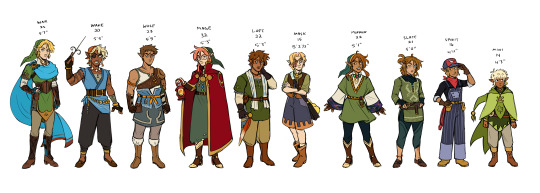


WOO, finally got this ref chart together! the art's actually kinda old by now (I started this back in february) but I didn't feel like redrawing everything outside outfit changes sooooo,,,,,my apologies 😅 here's the main cast! you can find individual refs in this masterpost
#height differences may be slightly inaccurate i forgot to take heel height into account sometimes#faq#bonus links#bonuslinksdotjpg#bonus content#bonus war#bonus wake#bonus wolf#bonus mage#bonus loft#bonus mask#bonus mirror#bonus slate#bonus spirit#bonus mini#all links#if ur familiar w bonus lore there are some slight changes here. again. sorry <3#bonuslinks#spoiler link
8K notes
·
View notes
Text
MCYT SEXYMAN WINNER JOE HILLS
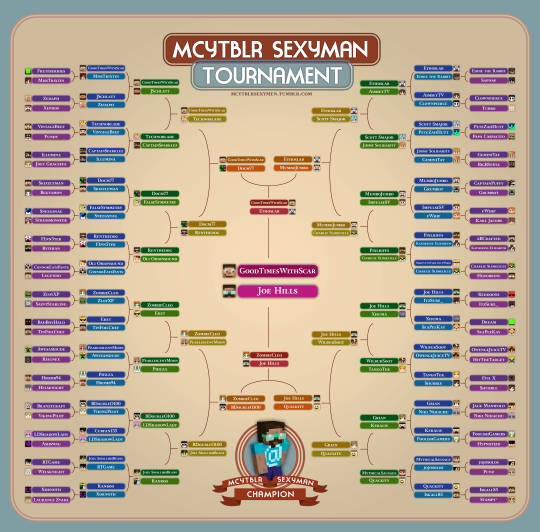
[ID: the sexyman bracket, showing that the final winner is Joe Hills]
13K notes
·
View notes
Text
1K notes
·
View notes
Text
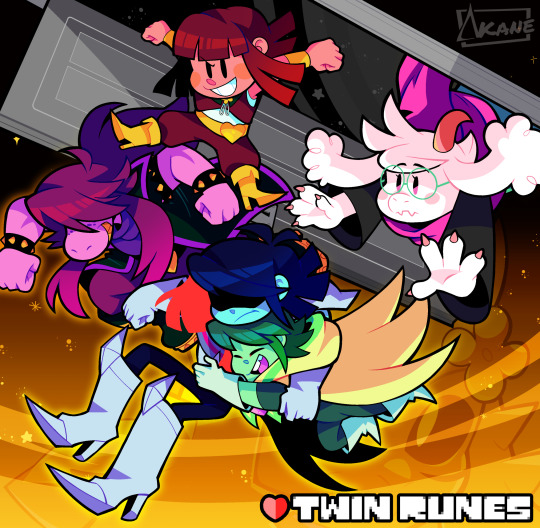
TWIN RUNES MASTERPOST
1 - 2 - 3 - 4 - 5 - 6 - 7 - 8 - 9 - 10 - 11 - 12 - 13 - 14 -15 - 16 - 17 - 18 - 19 - 20 - 21 - 21-1 - 21-2 - 21-3 - 22 - 23 -24 - 25 - 26 - 27 - 28 - 29 - 30 - 31 - 32 - 33 - 34 - 35 - 36 - 36-1 - 37 - 38 - 39 - 40 - 41 - 42 - 43 - 44 - 45 - 46 - 47 - 48 - 49 - 50 - 51 - 52 - 53 - 54 - 55 - 56 - 57
To be continued...
TWIN RUNES MINI COMICS
Glasses - Fallen down - First steps - Press [C] - Frisk Dance -
But nobody came - Whatstheirface - An acquired taste - Eye opening
______________________________________________________________
TWIN RUNES - FAQ
What exactly is this AU about?
Twin Runes is essentially a comedic crossover AU between the universes of Deltarune and Undertale. No fancy nicnacs. Just the characters being their chaotic selves. But there might be some darkness lurking up ahead...
When is the next comic?
The comic updates most Sundays at 6:30 PM Central European Time.
Why is this AU called Twin Runes?
The name is more or less a play on the typical naming format of most AU's by featuring the "Runes" part. There are no literal Twin Runes. The whole name is more of a stand in for Undertale and Deltarune as parallel worlds. Hence the "Twin" part.
When does Twin Runes take place?
This AU takes place between a hypothetical Chapter 3 and Chapter 4 of Deltarune. On the Undertale side of things, it takes place post neutral route just as Frisk was about to deliver Undyne's letter to Alphys.

Is the player a thing in this AU?
The player lost control over both human children as soon as Frisk entered the world of Deltarune.
When Chapter 3 and 4 are released, will it affect the story?
Any chapters after Chapter 3 won't affect the story in the grand scheme of things. If possible, I might make a reference to Chapter 3, but all in all Twin Runes created a new timeline so to speak.
What's up with Kris' and Frisk's hair?
The red bits of their hair is more or less a representation of their souls. That in turn is also why Chara doesn't have that feature. They are soulless. It's a stylistic choice.
What's that thing on Kris' chest?
It's a scar they got from tearing out their soul.
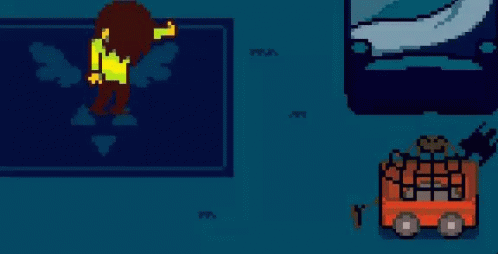
And why do they have weird lines all over their body?
Both Kris and Frisk's anatomy resemble that of ball-jointed dolls. They appear just as markings across their bodies. Think of them as elaborate birthmarks. Kris and Frisk are still made of flesh and blood, but are in fact hypermobile. The reason as to why they do is still a little secret :)
People here like to refer to these markings as "puppet limbs".
You can get a better look at them and the scar in this artwork
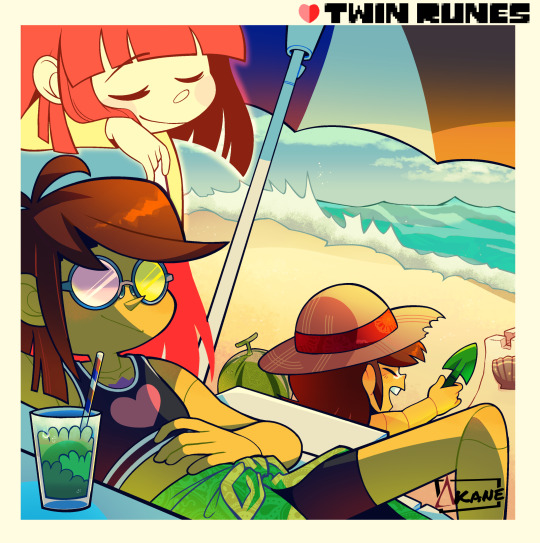
Why does Kris have braces?
This is why:
Why is Dark World Frisk green?
Frisk changes their main sweater colors with Kris when they enter the Dark World.
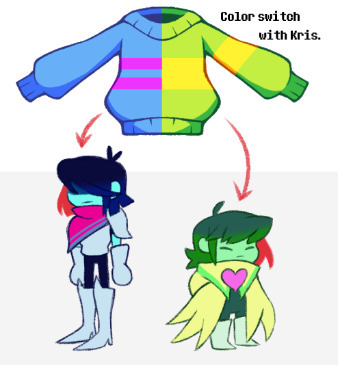
Can other ghosts see Chara? (pre Darkner transformation)
No, only Frisk and Kris are able to see Chara.
IS KRIS NOW FRISK'S COUNTERPART OR CHARA'S????
:)
So, was Chara in the locket all along?
No, Chara possessed the locket to become a Darkner.
Where are Jevil and Spamton? Are they in Castle Town?
The Fun Gang have already fought these two in the previous chapters and added them into their inventory. Outside of that little dream sequence, neither will be making an appearance.

Is anyone from Undertale Yellow gonna make an apperance?
Outside of a tiny cameo from Clover (that has no greater bearing on the story) no one from Undertale Yellow is going to make an appearance.
Is (insert character here) gonna go to the Dark World/underground?
With the way the story is going to play out, only the main group will be heading to this new Dark World. The rest of the story will be taking place there.
Is the Group Project miniseries canon to Twin Runes?
It was made before Twin Runes was conceived and before I had any idea I would make a series. It is it's own self-contained story.
So it is NOT canon to Twin Runes, but You can read it here:
1 - 2 - 3 - 4 - 5 - 6
How did you come up with the idea of Twin Runes?
Twin Runes is an offshoot of a separate script I wrote. It's a similar concept but turned on its head. The funny moments in that script made me just continue what now is the start of Twin Runes. I pretty much just wanted to see if I am actually capable of drawing a comic to begin with. So... in a way Twin Runes is my first attempt at a comic ever. If I ever finish Twin Runes, then I know I can tackle turning that mammoth project of a script into a comic too.
In the grand scheme of things these two projects are sister series. They have A LOT in common and even share similar plot elements. When Twin Runes is over you will automatically also know certain mysteries of The Other Script.
What is The Other Script?
As of this moment I call The Other Script: "Lost in the In-Between". At its core it's an inverse of Twin Runes. I.e. Kris falling into the underground and being aided by Frisk on their quest to return home. The story and jokes are a considerably more grounded than in Twin Runes and so are the characters. Though they do have their moments from time to time. The overall mood of that script is a lot darker in nature and it's a 200+ page passion project of mine.
Am I allowed to make fanart?
ABSOLUTELY! You are very welcome to make fanart if you feel like it. Please let me know if you do by tagging me, so I can share it with everyone to see so that you get the appreciation you deserve :)
Can I use the funny faces you draw for memes or for private stuff with friends?
That's what they're here for :)
Is there x ship in this comic?
The focus of the story is not on shipping. If it's in the game it will very likely be mentioned or brought up, but that's about it.
What pronouns do you go with for the human children?
I try to stick as close as possible to the games so I use THEY/THEM FOR ALL OF THEM WITHOUT ANY EXCEPTIONS.
______________________________________________________________
ABOUT ASKS
Asks will open for 24 hours after a new comic has been released. Your questions will then be answered over the course of the week.
Try not to submit multiple asks. If necessary, just keep everything in one post.
Keep in mind that I receive AL LOT of asks, so not every question can be answered...
Questions containing spoilers will not be answered on principle. Wouldn't be as fun if the surprise was ruined, right?
Before leaving an ask (mostly for everyone who's new), please make sure to read the FAQ section above. A lot of times your question might have been answered already :>
I love memes and dumb jokes as much as the next guy, but try not to spam
It probably goes without saying, but please stay civil. I want to give everyone the respect they deserve, and naturally like to be treated the same way.
Please be mindful about drawing requests. It is understandable if you're eager to see a certain character drawn in my style, but I do not like to be bombarded by requests. The more it happens, the less likely I am to do it. Be kind and ask nicely.
Don't use other people's posts that I reblogged to ask me questions! It has happened before and I do not wish to see this!
______________________________________________________________
REFERENCE SHEETS
The following are ref sheets of characters that don't have established Dark World forms yet (as of writing this comic). The list will be updated as soon as a new character enters the Dark World.
Here you will also find references of characters that might appear as surprise cameos, or maybe even completely new faces...


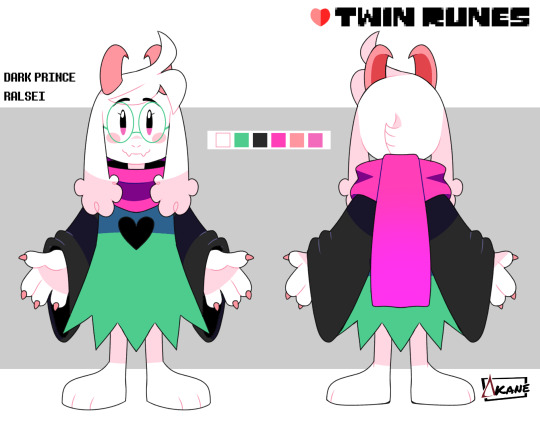

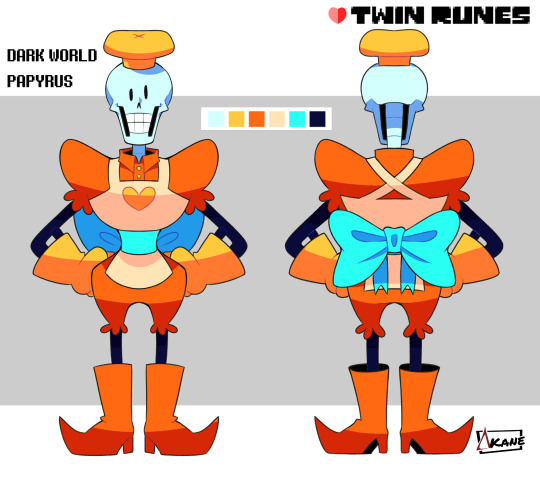

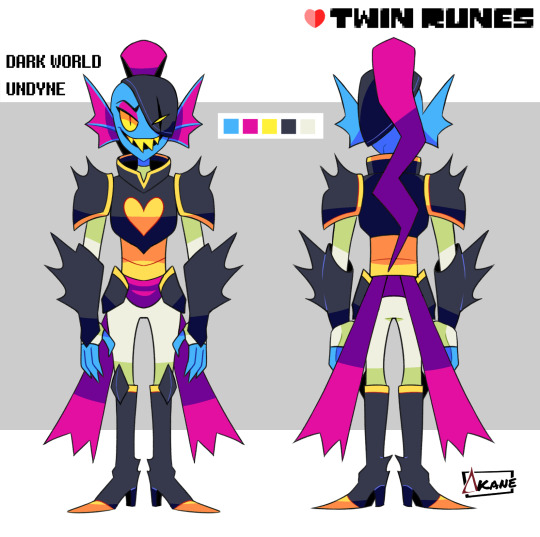

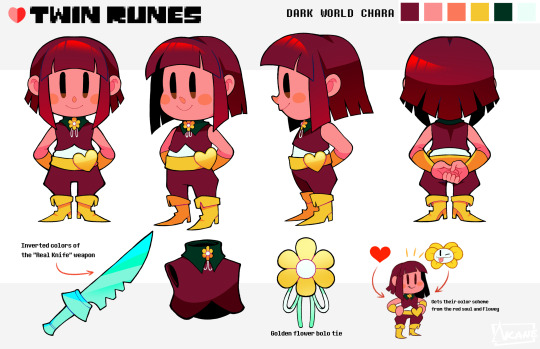
______________________________________________________________
FULL ART
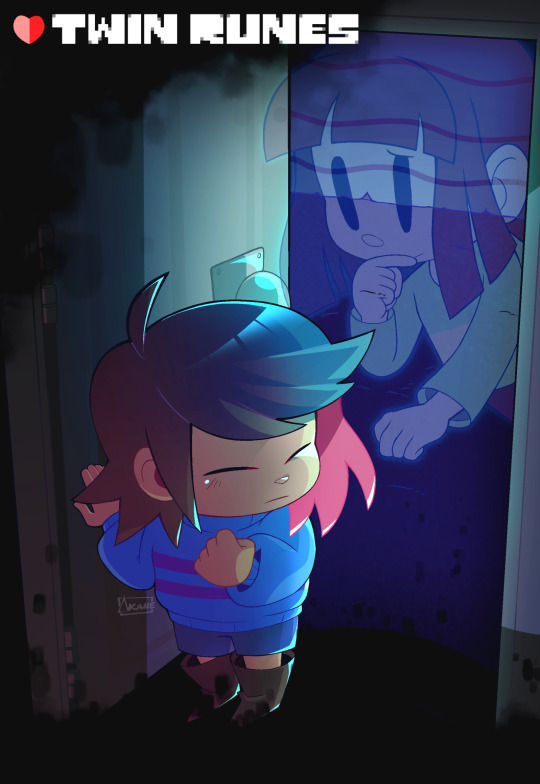



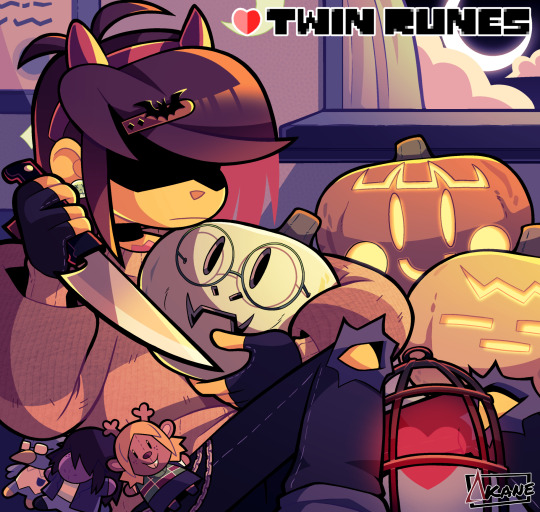


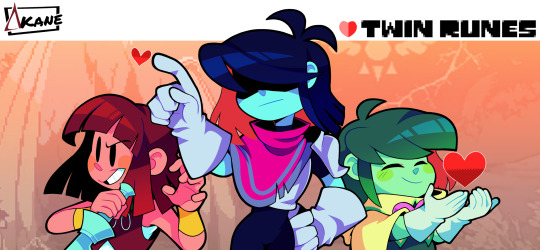

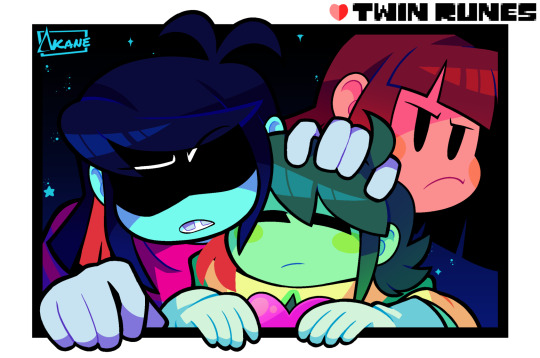
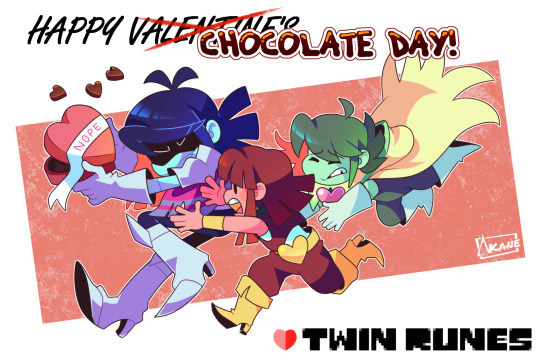

#twin runes#twin runes masterpost#masterpost#deltarune comic#comic#deltarune au#crossover#undertale#my art#FAQ#frequently asked questions#important#please read#deltarune
5K notes
·
View notes
Text
WARNINGS / FAQ / REQUESTS
asks are open! check here before sending :) (updated 3/10/24)
banned from BLAST for being too sexy
CREATURE WARNING:
this blog posts BEASTIES and ORGANISMS. if you are uncomfortable with seeing any manner of organism (spiders, rodents, fish, etc) please block the tags for that organism before following/browsing.
for broad categories: i tag in plurals (insects, bugs, fish, rodents, parasites, pathogens, plants, trees, etc.)for specific organisms: i tag in singulars (dobsonfly, eurasian harvest mouse, etc.)
for disease causing bacteria: i tag the illness it causes (malaria, botulism, etc.)
ADDITIONAL BUG WARNING: this blog posts a LOT of insects, especially moths.
FOR SCREENREADER USERS: by the nature of this blog, 99% of my posts will have large sections of unformatted letters, and therefore aren't very screenreader friendly.
If I ever miss a tag or you'd like to request that I tag something, please send me a message.
FREQUENTLY ASKED QUESTIONS:
Are you a bot?:
no, just neurodivergent
How do you do this?:
i delete everything in a message except for the letters A, T, C, and G. then, i BLAST it with my wizard beams.
Are you Italian?:
my lawyer has advised me not to answer this question
How do I request things?:
read the REQUESTS section of this post :)
Why are there so many bugs???:
1. insects make up almost 80% of all animal life on earth
2. they are relatively easy to study, so there's more bug DNA in the BLAST database.
Okay but why so many MOTHS???:
because scientists are not immune to bias. moths are pretty looking and easy to study, so there is more moth DNA in the BLAST database.
Do the punctuation marks/emojis mean anything to BLAST?:
no, i just keep them there after my first pass of a text so you can easily recognize i'm using that same text to find an organism.
Can I send in general questions?:
yes! but they may get BLASTed.
REQUESTS:
to request something, please read this section and then send an ask.
asks that don't follow these guidelines will be deleted, and may get you blocked.
For questions: make sure it hasn't been already answered in the FAQ, then send.
For songs, poetry, bible verses, or otherwise long text (over 1500 characters, or text with a lot of spacing): send a link to the text or a pastebin with the text in it.
For Tumblr posts: send a link.
For other languages: make sure it's romanized (in latin script), then send.
REQUESTS I WILL NOT ANSWER:
things i have already answered. search the blog for whatever you're about to submit, and check the Frequently Requested section before sending.
private information (name, address, etc. YES people have tried this.)
images (including images in your text is fine, as long as there's enough text that i can search with it)
AAAAAAAAAAA, GATCAGTCAGATTCCGACGGT, CATCATCATCAT, etc. get creative with it.
spam. you only have to send a request once.
homestuck
FREQUENTLY REQUESTED:
The Bee Movie Script, navy seals copypasta, AM hate monologue, All Star, Yoshikage Kira, Never Gonna Give You Up, man door hand hook car door, Big Bill Hells, FNAF Connection Terminated, JURGEN LEITNER, Eggman's Announcement, Free Bird, Spiders Georg, Weed Smoking Girlfriends, Ebony Dark'ness Dementia Raven Way, Minos Prime, Steamed Hams, (this list will be updated as we go!)
thank you for reading! as a treat, enjoy this Strelitzia reginae, or Birds of Paradise flower. :)
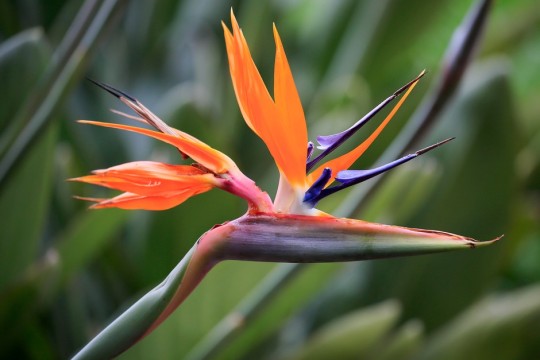
#hellsitegenetics#faq#intro post#flowers#plants#requests#birds of paradise#asks#remember to keep checking back!
1K notes
·
View notes
Text
WritingWithColor FAQ: How do I start writing a character of color?
First, be mindful that no race, culture, or ethnicity makes one inherently predisposed to certain emotions or personalities, despite what stereotypes or TTRPGs may suggest. We are all humans who share the same range of emotions and ways of thinking, even if we have different values.
Understand that there is no single template for a good [race, ethnicity] character. A person’s social, economic, and geographical background influences their life and values just as much as their race, culture, or religion. Consider: a Black American boy who grew up in a California mansion versus a Black American boy who grew up on an Illinois cornfield versus a Black boy who grew up in an apartment one city over. All three will have very different privileges, disadvantages, and outlooks on life.
Further reading (WWC x NaNoWriMo):
The Do’s of Writing PoC
Properly Coded: Creating Characters of Color
3 Ways to Show a Character's Culture
---
This Q&A is an excerpt from our General FAQ for Newcomers, which can be found in our new Masterpost of rules and FAQs. For more general resources on POC representation, check it out!
-Writing With Color
#writing with color#writeblr#representation#poc representation#writers on tumblr#writing advice#writing tips#faq
2K notes
·
View notes
Text
head up if you don’t want tumblrs partnered ai companies automatically scraping your blog for image datasets, you need to manually opt out.
You can’t do this in the app rn (apparently you can but I couldn’t find it so you might have to update), only the desktop version or web browser on your phone. It will also need to be done for every sideblog you have.
You find it by opening up your blog settings > scroll down to visibility > prevent third party sharing
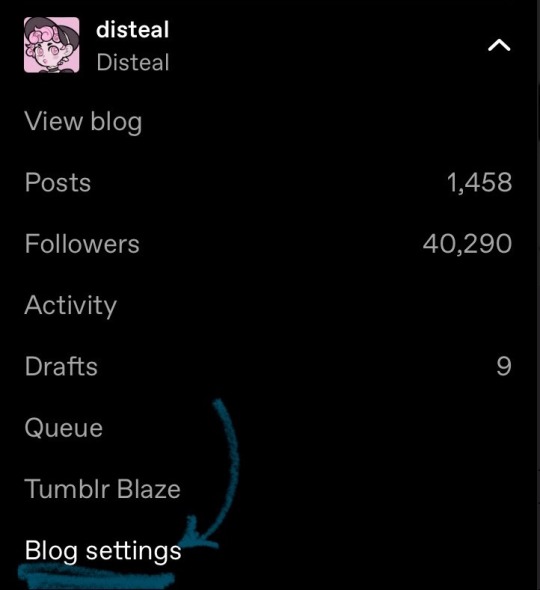
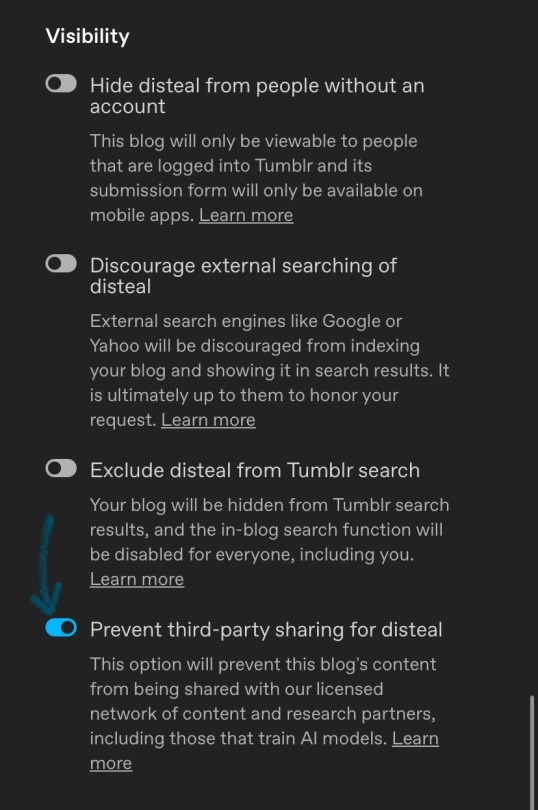
As an aside, I’d thoroughly recommend opting out of having your blog scraped, even if you’re not an artist. Afaik Tumblr hasn’t explicitly stated which companies they’ll be partnering with, but the vagueness of that wording is really alarming.
These datasets use a lot of selfies for photorealistic results, moderation of who has access to these datasets is notoriously ass, and a lot of AI engines are being used to generate pornography and racist imagery (you can see this rn with the rise of ai generated propaganda). While ‘your likeness is used in an awful generated image without your consent’ IS a worst case scenario, it’s a really upsetting one. Protect yourselves.
#dis.txt#ai discourse#ik this is all on tumblr faq but i can’t stomach reblogging their ridiculous staff post#it’s not staffs fault bc matt has been salivating at the chance for this for months now apparently#but the language rly cushions from how shit this is#faq
1K notes
·
View notes
Text

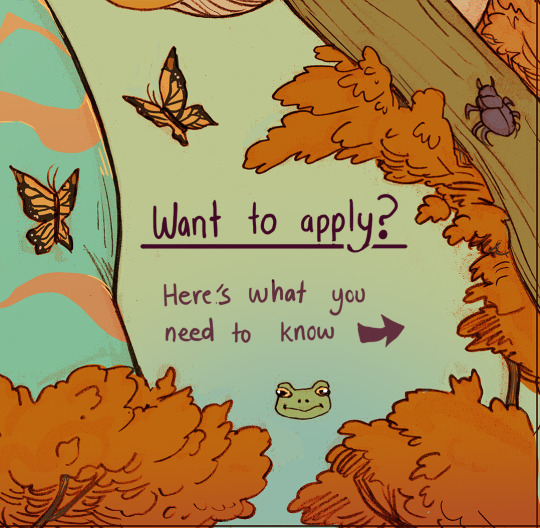



Butch Fairy Zine: Answering questions
What art style are we looking for? What is the estimated timeline? Will you get paid? we answer them here!
We will be answering more questions and posting them in the days leading up to the artist application form opening. So if you have questions, use our inbox, or you can fill in our interest form and leave them at the bottom. And if you have queries for the frog, you can leave them there too. He is very busy, so keep that in mind.
Find the interest form here.
Our Artist Application form will open on the 12th of January 2024.
text version under the cut
What type of artists are you looking for? And are you after a specific style or a range of styles?
We are looking for artists who can create pieces with fully rendered fairies and a background within the specified schedule. These can be digital artworks that are flat colour artworks, paintings, a mixture, or another style entirely.
We will also accept mixed media and traditional artworks, but they will need to be scanned at a minimum of 300dpi.
~
When you sign up for an artist position, are there any requirements to be a part of the team?
E-mail communication is required (discord is optional).
You must have a PayPal account to receive payment.
You must be able to communicate comfortably in English.
You must be 18 or older at the time of signing the contract by the 16th of February.
~
For artists accepted into the zine what would be the timeline for completing and submitting artwork?
Our current schedule for the artists requires concept ideas to be submitted by Feb 16th, and the final version by May 16th! Progress check-ins will be on Feb 29th, March 21st, and April 11th.
(In the image there is also a table including this information as well as the final submissions date being May 16th)
~
When the zine is for sale, where would the profits go to (charity, zine admin, etc.)?
We are aiming to hold pre-orders in June/July of 2024, with a flat fee paid to all contributors and additional proceeds split between contributors and mods.
Our priority is to make sure each contributor is paid fairly for their work. If sales do well enough, 20% will be used for future books and projects, and 80% split between taxes and fees, production costs, contributors and shipping costs.
~
Is this physical or digital and will there be prints of the art available? Got any merch ideas planned to go along with the zine?
Both physical and digital! Our goal is to make a 210 x 148 mm (A5) perfect-bound soft cover book.
We also plan to add some paper merch, including prints of some of the art from the book. Additional merch ideas include stickers, sticker sheets and bookmarks.
1K notes
·
View notes
Text
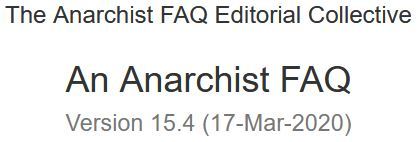
A.2.12 Is consensus an alternative to direct democracy?
The few anarchists who reject direct democracy within free associations generally support consensus in decision making. Consensus is based upon everyone on a group agreeing to a decision before it can be put into action. Thus, it is argued, consensus stops the majority ruling the minority and is more consistent with anarchist principles.
Consensus, although the “best” option in decision making, as all agree, has its problems. As Murray Bookchin points out in describing his experience of consensus, it can have authoritarian implications:
“In order… to create full consensus on a decision, minority dissenters were often subtly urged or psychologically coerced to decline to vote on a troubling issue, inasmuch as their dissent would essentially amount to a one-person veto. This practice, called ‘standing aside’ in American consensus processes, all too often involved intimidation of the dissenters, to the point that they completely withdrew from the decision-making process, rather than make an honourable and continuing expression of their dissent by voting, even as a minority, in accordance with their views. Having withdrawn, they ceased to be political beings--so that a ‘decision’ could be made… . ‘consensus’ was ultimately achieved only after dissenting members nullified themselves as participants in the process.
“On a more theoretical level, consensus silenced that most vital aspect of all dialogue, dissensus. The ongoing dissent, the passionate dialogue that still persists even after a minority accedes temporarily to a majority decision,… [can be] replaced… .by dull monologues — and the uncontroverted and deadening tone of consensus. In majority decision-making, the defeated minority can resolve to overturn a decision on which they have been defeated — they are free to openly and persistently articulate reasoned and potentially persuasive disagreements. Consensus, for its part, honours no minorities, but mutes them in favour of the metaphysical ‘one’ of the ‘consensus’ group.” [“Communalism: The Democratic Dimension of Anarchism”, Democracy and Nature, no. 8, p. 8]
Bookchin does not “deny that consensus may be an appropriate form of decision-making in small groups of people who are thoroughly familiar with one another.” But he notes that, in practical terms, his own experience has shown him that “when larger groups try to make decisions by consensus, it usually obliges them to arrive at the lowest common intellectual denominator in their decision-making: the least controversial or even the most mediocre decision that a sizeable assembly of people can attain is adopted—precisely because everyone must agree with it or else withdraw from voting on that issue” [Op. Cit., p.7]
Therefore, due to its potentially authoritarian nature, most anarchists disagree that consensus is the political aspect of free association. While it is advantageous to try to reach consensus, it is usually impractical to do so — especially in large groups — regardless of its other, negative effects. Often it demeans a free society or association by tending to subvert individuality in the name of community and dissent in the name of solidarity. Neither true community nor solidarity are fostered when the individual’s development and self-expression are aborted by public disapproval and pressure. Since individuals are all unique, they will have unique viewpoints which they should be encouraged to express, as society evolves and is enriched by the actions and ideas of individuals.
In other words, anarchist supporters of direct democracy stress the ”creative role of dissent” which, they fear, “tends to fade away in the grey uniformity required by consensus.” [Op. Cit., p. 8]
We must stress that anarchists are not in favour of a mechanical decision making process in which the majority just vote the minority away and ignore them. Far from it! Anarchists who support direct democracy see it as a dynamic debating process in which majority and minority listen to and respect each other as far possible and create a decision which all can live with (if possible). They see the process of participation within directly democratic associations as the means of creating common interests, as a process which will encourage diversity, individual and minority expression and reduce any tendency for majorities to marginalise or oppress minorities by ensuring discussion and debate occurs on important issues.
#faq#anarchy faq#revolution#anarchism#daily posts#communism#anti capitalist#anti capitalism#late stage capitalism#organization#grassroots#grass roots#anarchists#libraries#leftism#social issues#economy#economics#climate change#climate crisis#climate#ecology#anarchy works#environmentalism#environment#solarpunk#anti colonialism#mutual aid#cops#police
20 notes
·
View notes
Text


my storybook is now live! link to PO on my profile!!! (rbs are appreciated!)
happy 3rd life anniversary! 💚💛❤️
#desert duo#grian#goodtimeswithscar#3rd life smp#desertduo#hermitcraft#trafficblr#hermitblr#third life smp#faq
1K notes
·
View notes